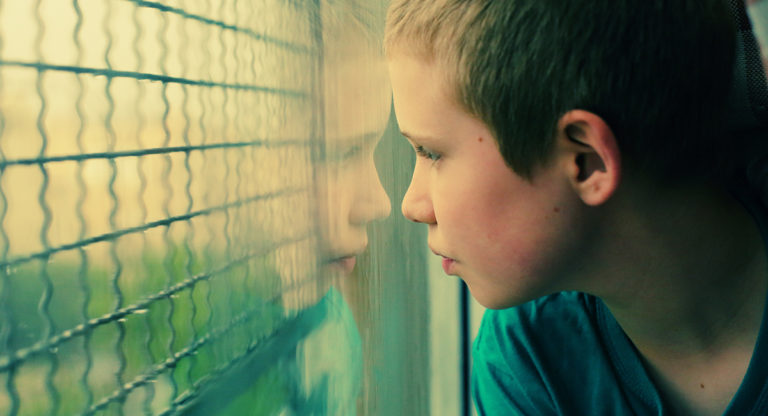Anxiety in Our Children: How They Sleep, What They Eat, How They Move, The Basics
by Sara Erling
 We have all heard it a thousand times: eating better, sleeping better, getting physical exercise helps our overall health. While this is something that our NACD families in general are very conscious about with their children with developmental issues, it is not uncommon to hear that those rules don’t really apply to everyone in the family. Let’s face it, it is easier to be more lenient on our neurotypical kids or ourselves, but does that help everyone in the long run? It is important to really get serious across the board about our overall physical health in the family, as that impacts our mental health significantly.
We have all heard it a thousand times: eating better, sleeping better, getting physical exercise helps our overall health. While this is something that our NACD families in general are very conscious about with their children with developmental issues, it is not uncommon to hear that those rules don’t really apply to everyone in the family. Let’s face it, it is easier to be more lenient on our neurotypical kids or ourselves, but does that help everyone in the long run? It is important to really get serious across the board about our overall physical health in the family, as that impacts our mental health significantly.
Sleep is such an important part of one’s life. According to the National Sleep Foundation, children ages 6-13 years old need 9-11 hours of sleep each night to be at their best. Teenagers ages 14-17 need 8-10 hours of sleep to be at their best, and adults should have between 7-9 hours of sleep per night. This is good, quality sleep! Not being in bed on your smartphone scrolling, but actually ASLEEP! Unfortunately for most teens, their biological clocks shift during that stage, where they tend to have more energy at night, increasing the desire to stay up later and sleep in longer. If your children are like mine, they start school at 7:20. They are up and out of the house before 7am. This can leave them already sleep deprived as they aren’t always ready to fall asleep by 10pm the night before. A study from the British Medical Journal in 2015 researched the effects of screen time and lack of sleep in a substantial sample of adolescents, over 9000. They found that the more screen time the subjects engaged in each day, the longer it took for them to fall asleep. If they had four or more hours of screen time per day, they were 360% more likely to have less than five hours of sleep a night and 49% more likely to take over an hour to fall asleep (Hysing, M. et al, 2015). When our brains are tired, mental health issues such as depression and anxiety increase. We are not able to think as clearly and have more difficulty handling stress than when in a rested state. NACD recommends consistent nighttime bed routines starting when children are little, such as no screens in the bedrooms, and devices are to stay with parents. We suggest having at least an hour to an hour and a half of no screens prior going to bed. We also encourage very dark rooms (blackout shades or curtains) and white noise to help facilitate a good night’s rest.
I hear many times “my kid has a balanced diet; they eat some of everything every day.” But how much of those foods happen to be processed? Have extra or hidden sugars? Artificial ingredients? More and more research on the foods we eat are targeting how they impact our mental health. “In recent years, a direct relation between the occurrence of anxiety disorders, sleep disturbances, and mood disorders has been observed as a consequence of poor or inadequate diet. Eating habits in Western societies have greatly changed in recent decades, with an increase in the consumption of foods low in vitamin and mineral content, high in caloric value, and rapidly prepared and easily consumed.” (Fernandez-Rodriguez, M., et al., 2017) There is a direct interrelationship between physiological health and neurological function. NACD has known this since its inception in the ‘70s. Time and time again our clients have shown that those who eat better function better. In general, diets rich in plant based foods, healthy fats (in the form of plants, nuts, seeds, and fatty fish like salmon), and lean meats are far superior in promoting mental function. In contrast, diets high in sugar, dairy, breads, and processed foods have been shown to be related to depression, chronic inflammation, and anxiety. This isn’t just for adults! According to Natalie Kling, a Certified Clinical Nutritionist from NACD’s Professional Advisory Committee, “the human body is always moving towards homeostasis, or perfect balance. When a body is out of balance, we see or experience symptoms (physical AND mental). We can soothe symptoms by giving the body the interior environment it needs to return to balance. Rest, hydration, oxygen, nutrients, detoxification, and a healthy and loving environment provide the ingredients the body needs to repair, regenerate, and reorganize. In contrast, when we introduce processed foods, sugar, not enough sleep, chemicals, environmental toxins, or stress, we push the body out of balance and create obstacles to the body’s ability to thrive.”
Personally, I have noticed a great difference in my son’s “teenager attitude” when he doesn’t eat these foods. When his diet is clean, whole food based, there is a positive difference. Often times I see parents eating healthy, but their kids are eating foods loaded with sugar and the “bad stuff” because “they’re kids.” NACD suggests to parents to develop a palate for healthy food with their children in infancy. NACD recommends to our families to work with one of our nutritionists if you need help in getting started. Natalie Kling, who also happens to be an NACD mom, has suggested that parents can start by just focusing on getting more vegetables into your kids. Smoothies (without added sugars and dairy), homemade sauces, etc., are ways to start that process. If you are a new parent with young children, keep their diets high in plant-based foods so that they develop a taste for it. If you are a parent with a picky eater, they don’t have to be. By giving the brain and body the correct fuel it needs, this can help to improve your child’s physical AND mental health as well.
Many children and adults struggle with anxiety due to lack of physical exercise. If we sit back and look at our lives today, we lead more sedentary lifestyles. We watch our TVs, screens, sit and scroll through our phones, many of us work all day at a desk, and many of our children are in school for 6+ hours (sitting for a huge chunk of that), many without daily physical exercise. According to the US Department of Health and Human Services (2018), children ages 3-5 years of age should engage in at least 3 hours of physical activity with varying degrees of intensity. Children ages 6-17 should engage in moderate to vigorous physical activity (aerobic, muscle, and bone strengthening) for 60 minutes DAILY. Adults should have a similar amount. Do you get that? Do your children? Exercise stimulates endorphins in your brain that allow for improved executive function, attention, and mood. Essentially, it allows you to handle stress better and not let it handle you. NACD recommends families make an effort to include physical exercise as part of your day. Schedule it in. In fact, on some of our programs we will write screen time = chore time = exercise time. For my children, the screens, homework, and chores don’t happen after school until physical exercise does. It might be going to the gym or doing an online video. Sometimes it is going for a run or even a fast walk. Snow or sun, we make it a priority.
In conclusion, it is important that as parents we really understand how significant lack of sleep, poor diets, and lack of physical exercise impacts our children’s physical and mental health. They work together, impacting one another. NACD looks at the whole child and sees this as a huge piece to impacting the global mental function of a child.
Reprinted by permission of The NACD Foundation, Volume 32 No. 1, 2019 ©NACD
References
Fernández-Rodríguez, M., Rodríguez-Legorburu, I., & López-Ibor Alcocer, M. I. (2017). Nutritional supplements in anxiety disorder. Actas Espanolas De Psiquiatria, 45(Supplement), 1.
Hysing, M., Pallesen, S., Stormark, K. M., Jakobsen, R., Lundervold, A. J., & Sivertsen, B. (2015). Sleep and use of electronic devices in adolescence: Results from a large population-based study. BMJ Open, 5(1), e006748-e006748. doi:10.1136/bmjopen-2014-006748
How Much Sleep Do We Really Need? (2019). Retrieved February 5, 2019, from https://www.sleepfoundation.org/excessive-sleepiness/support/how-much-sleep-do-we-really-need
U.S. Department of Health and Human Services. Physical Activity Guidelines for Americans, 2nd edition. Washington, DC: U.S. Department of Health and Human Services; 2018.


